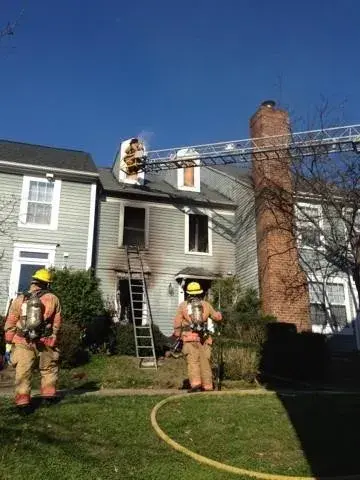The U.S. Department of Homeland Security (DHS) Science and Technology Directorate’s (S&T) First Responders Group (FRG) relies on experienced emergency response and preparedness professionals to guide its research and development efforts. The First Responder Resource Group (FRRG) fills that role. An all-volunteer working group, the FRRG helps S&T maintain focus on the top-priority needs of responders across the nation. This series highlights several FRRG members, offering a glimpse into their daily responsibilities, as well as their ongoing support of S&T technology development.

“Maybe I was lucky. I never knew how perfect this profession would be for me. I love what I do and
wake up every day excited about going to work, which, unfortunately, is not a very common thing.”
Jason Smith had planned on a life in the military. But one of life’s unexpected turns left him with a severed Achilles tendon and an end to his ROTC scholarship. Suddenly looking for other options, Smith knew he wanted to take on a career that would allow him to serve his community and have a positive impact on other people’s lives. That career path led him to the Montgomery County Fire and Rescue Service (MCFRS).
In 2005, Smith graduated with a Bachelor’s of Science degree in emergency health services from the University of Maryland, Baltimore County. That same year he became a nationally registered EMT-Paramedic. He advanced to critical care EMT-Paramedic and is now pursuing his master’s degree in emergency services management.
While attending college, Smith volunteered with the Wheaton Volunteer Rescue Squad in Montgomery County, Maryland. He took on additional training including certification as a HAZMAT technician; driving/operator of engines, trucks and squad vehicles; and a trip to New Mexico for DHS Energetic Materials Research and Testing Center training.
It wasn't long before Smith rose through the ranks to lieutenant, his current rank. When asked about the most memorable thing that has happened on the job, he said, “delivering babies.” “To date, I have personally delivered nine. That is always an exciting and uplifting scenario. We spend our days running call after call, and unfortunately, they do not always have positive outcomes. We remember those calls and try to learn from them. But for me, aside from the adrenaline-filled fire or rescue calls, I would have to say the most memorable, and the ones I’m most proud of, are the deliveries.”
 Life as a firefighter keeps Smith busy. Montgomery County’s vast area and proximity to Washington, D.C., ensures the challenges for the county’s emergency services don’t let up for long.
Life as a firefighter keeps Smith busy. Montgomery County’s vast area and proximity to Washington, D.C., ensures the challenges for the county’s emergency services don’t let up for long.
Smith described the diverse locations MCFRS is tasked with serving as everything from dense urban areas to rural farm lands. “We have one station with a first response area that’s larger than all of Washington, DC.”
Given this environment, it is imperative for firefighters such as Smith to stay connected with the growing number of new technologies available to fire and rescue services.
It was by taking part in the development of the Improved Structure Firefighting Glove that Smith first participated with FRRG. His role primarily included testing prototypes and providing feedback from the viewpoint of a first responder. Smith also traveled to Chicago for the final evaluation of the glove.
“I truly believe that having a group of firefighters who wear the fire gloves on a daily basis, and who were able to focus on the development of these gloves to real world needs, has enabled Shelby Glove to produce a superior product. I could not be happier with the end result.”
Smith attended the FRRG annual meeting for the first time this year. Since then, his interest in the group’s mission has grown stronger. He said FRRG has influenced how he thinks during his time on the job. Even when running calls, he takes notes on what his team could use to improve how they operate. He finds it interesting that new technology, while never a substitute for real life training and experience, can keep emergency personnel safer and help them become more proficient in their daily efforts.
The meeting’s prototype demonstrations allowed Smith the opportunity, not only see the technology himself, but also to witness reactions to the new structural firefighting glove that he took part in developing. Smith said he was most impressed with search and rescue technology such as FINDER (Finding Individuals for Disaster and Emergency Response).
“Jason has been a true asset to the First Responders Group. The knowledge and input he provided throughout our testing and during the operational field assessment held in Chicago had a major impact on what Shelby Glove ultimately commercialized,” said Greg Price, Director of FRG’s Responder Technologies (R-Tech) division, and the Program Manager for the Improved Structure Firefighting Glove. “He’s been just as instrumental in providing subject matter expertise for other technology development efforts R-Tech has considered making investments in,” Price continued. “First responders like Jason, who have a passion to improve efficiency, effectiveness and safety through cutting edge technology, allow R-Tech to continue to be successful.”
Smith highly encourages other emergency responders to consider becoming involved with FRRG.
“I would absolutely recommend participation in the FRRG to my peers,” he stressed. “To my knowledge, there is no other venue where we can directly affect change in our daily lives as first responders, from a technological standpoint, at such a drastic level. I truly feel that if we had more involvement from first responders we could greatly increase the efficiency of the program.”
Check back soon for additional FRRG member spotlights. For more information on how to become a member of the FRRG, contact first.responder@hq.dhs.gov.
